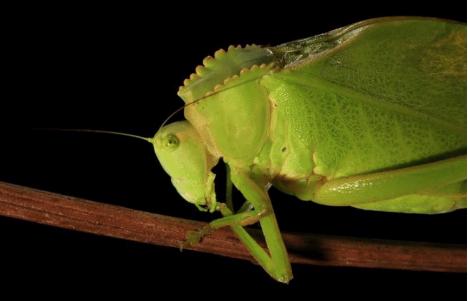What did the katydids do when picking up bat sounds?

Steirodon stalii
Credit: Laurel Symes
When predator and non-predator cues are similar in the same habitat
Ecosystems can be incredibly complex, with many interacting species. In many habitats, predators shape they behavior of prey and prey shape the behavior of predators. This paper provides a detailed look at the predator-prey relationship between bats and katydids, a group of insects related to crickets and grasshoppers.
Some species of bats hunt katydids by eavesdropping on their mating calls. However, katydids aren’t defenseless. Many species of katydids have ears that can hear the ultrasonic echolocation calls of bats. In some habitats, katydids stop calling when they hear the echolocation calls of bats. We studied katydids in Neotropical forests and predicted that they would stop calling when they heard the echolocation calls of approaching bats. What we found was a surprise – most of the katydid species continued calling even when hearing the echolocation calls of predatory eavesdropping bats.
In Neotropical forests, there are many species of bats. Some of these bats eat fruit and others catch flying insects. Most of these bat species are no risk to a perched, singing katydid. However, all of these bats produce echolocation, so while the forest is full of echolocation calls, less than 4% of those calls come from bats that might eavesdrop on katydid calls. For a katydid, this means that calling is very risky, but because there are so many bats producing echolocation calls, if katydids stop singing when they hear echolocation, they would have few opportunities to attract a mate.
By measuring the neural activity from their ears, we know that katydids are capable of hearing bats, but most of the species that we studied sing at the same rate, regardless of whether they are hearing bats. Most of the species that we studied have a more proactive strategy, using very short, very rare calls. Many species produce very little sound…less than two seconds per insect per night!
This is a cool example of how the evolution of predator-prey relationships is affected by other species in the environment, underscoring the complex and interconnected dynamics of natural ecosystems.
###
Symes LB, SJ Martinson, CE Kernan, and HM ter Hofstede. Sheep in wolves’ clothing: prey rely on proactive defences when predator and non-predator cues are similar. Proceedings of the Royal Society B: Biological Sciences https:/
Media Contact
All latest news from the category: Life Sciences and Chemistry
Articles and reports from the Life Sciences and chemistry area deal with applied and basic research into modern biology, chemistry and human medicine.
Valuable information can be found on a range of life sciences fields including bacteriology, biochemistry, bionics, bioinformatics, biophysics, biotechnology, genetics, geobotany, human biology, marine biology, microbiology, molecular biology, cellular biology, zoology, bioinorganic chemistry, microchemistry and environmental chemistry.
Newest articles

NASA: Mystery of life’s handedness deepens
The mystery of why life uses molecules with specific orientations has deepened with a NASA-funded discovery that RNA — a key molecule thought to have potentially held the instructions for…

What are the effects of historic lithium mining on water quality?
Study reveals low levels of common contaminants but high levels of other elements in waters associated with an abandoned lithium mine. Lithium ore and mining waste from a historic lithium…

Quantum-inspired design boosts efficiency of heat-to-electricity conversion
Rice engineers take unconventional route to improving thermophotovoltaic systems. Researchers at Rice University have found a new way to improve a key element of thermophotovoltaic (TPV) systems, which convert heat…



